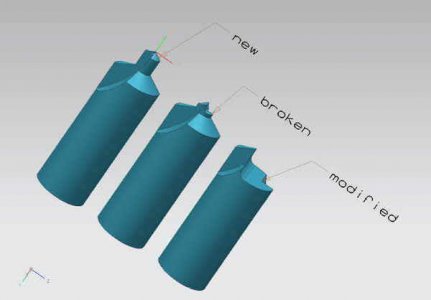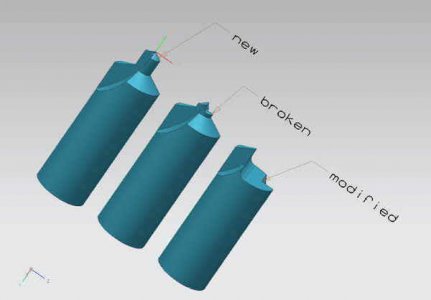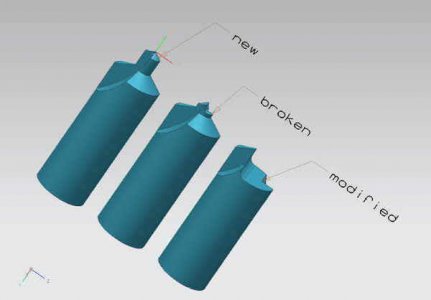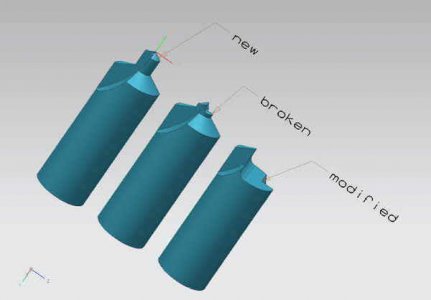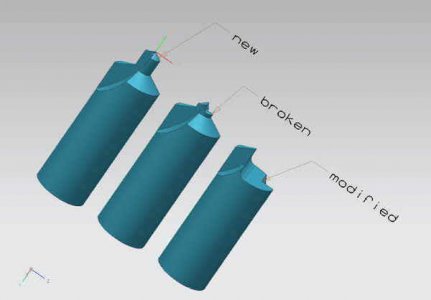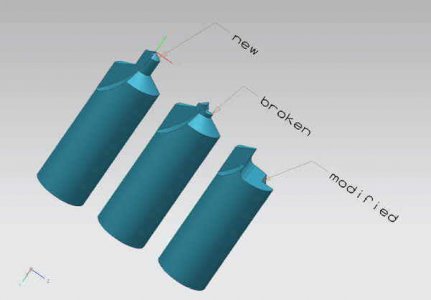-
Welcome back Guest! Did you know you can mentor other members here at H-M? If not, please check out our Relaunch of Hobby Machinist Mentoring Program!
You are using an out of date browser. It may not display this or other websites correctly.
You should upgrade or use an alternative browser.
You should upgrade or use an alternative browser.
Broken Center Drill In Work Piece
- Thread starter HBilly1022
- Start date
- Joined
- Jan 31, 2016
- Messages
- 11,486
Diamond coated dremmel bits and lots of them. I used them to remove a broken drill bit and small tap. Princess auto sells inexpensive packs.
My last venture of broken in a hole was a drill bit trying the remove broken head bolt in my cub cadet 122. Lucky there was hole all way through. I used a punch same size as the drill and punched it through.
Jack
Sent from my SGH-I337M using Tapatalk
Hey Jack ! Sorry to hear about the broken drill but that old Cub is worth any price of tooling to keep it going . It's my " hobby " !!

Face the broken end of the center drill off flat at the juncture of the 60 degree section and the "pilot", Drill a hole the diameter and depth of the "pilot" that you broke off in the center drill. Use this new tool to drill out the tip broken off in the workpiece.
- Joined
- Dec 6, 2012
- Messages
- 2,677
Sometimes they can be knocked loose with a center punch.
Mostly start over.
Very slow rpms (1/2 what I calculate I should run the same size drill at), only sharp center drills, lots of oil, and use the quill to peck.
Well, at least that's what I read somewhere.
Daryl
MN
Mostly start over.
Very slow rpms (1/2 what I calculate I should run the same size drill at), only sharp center drills, lots of oil, and use the quill to peck.
Well, at least that's what I read somewhere.
Daryl
MN
- Joined
- Nov 5, 2016
- Messages
- 1,419
IMO, most center drills are broken because they are run too slow, with too much feed and not enough oil. I run mine fast (faster than a drill of the same size) with very light feed, plenty of oil and peck frequently.
YMMV,
Ted
YMMV,
Ted
- Joined
- Dec 6, 2012
- Messages
- 2,677
TechTed,
Thanks for calling me to task.
I'm having difficulty finding anything on center drill speeds on the net.
However, I did learn lots about spotting drills. Learned huge heaps!
Turns out I've been using center drills as spotting drills. A poor use of the tool!
I'm planning to search the Machinery's Handbook later this week for a center drill speed recommendation.
I've certainly been wrong before. Ask my wife she'll tell you all about it....
Thank you!
Daryl
MN
Thanks for calling me to task.
I'm having difficulty finding anything on center drill speeds on the net.
However, I did learn lots about spotting drills. Learned huge heaps!
Turns out I've been using center drills as spotting drills. A poor use of the tool!
I'm planning to search the Machinery's Handbook later this week for a center drill speed recommendation.
I've certainly been wrong before. Ask my wife she'll tell you all about it....
Thank you!
Daryl
MN
- Joined
- Nov 5, 2016
- Messages
- 1,419
I'm terrible with feeds and speeds... In the past, where there was a need or major advantage I have used the book to calculate feed and speed values, but 99% of the time I just wing it. I go more by the chips that are produced than anything... I use mostly HSS now since I'm retired and have an early 1930's South Bend lathe. I also have a Brown and Sharpe 2B horizontal mill that I mounted a Bridgeport M head on which is from the same era. Carbide tooling is expensive and I enjoy grinding my own tools and they run best on my machines since they were made mainly to use HSS. If the chips are coming off with a color I don't like (blue or heavy straw) I slow things down a little.
On a lathe, mill, drill press, whatever, I run center drills fast because they break so easily. So, if the tip of a center drill is 1/8", I would run it faster than I would run a 1/8" drill since I'm not going in very deep and they are usually made out of pretty high quality HSS. With a lot of oil and pecking, there is very little heat build up and the likelihood of dulling or breaking is low.
With experience you will find what works best for you and your equipment. That is what makes this hobby (or profession) fun! Everyone is different. But years ago when I was first learning, all the old timers told me to run the snot out out center drills if I didn't want to break them.
Ted
On a lathe, mill, drill press, whatever, I run center drills fast because they break so easily. So, if the tip of a center drill is 1/8", I would run it faster than I would run a 1/8" drill since I'm not going in very deep and they are usually made out of pretty high quality HSS. With a lot of oil and pecking, there is very little heat build up and the likelihood of dulling or breaking is low.
With experience you will find what works best for you and your equipment. That is what makes this hobby (or profession) fun! Everyone is different. But years ago when I was first learning, all the old timers told me to run the snot out out center drills if I didn't want to break them.
Ted
- Joined
- Apr 9, 2013
- Messages
- 92
I re-purposed a 1/8" concrete drill, the type with a slice of carbide in the tip, by sharpening the carbide on a diamond hone. This was hard enough to remove a broken HSS drill from a workpiece that had a significant amount of machining already completed. Seems like drills and taps only break when most of the work is already done ;-)
Another alternative would be to make a tap burner type EDM. I always think about doing this but never get around to it...
If you don't have a spotting drill, try a screw machine length drill with a split point - this works well if you start with modest pressure so the drill doesn't get forced off center.
John
Another alternative would be to make a tap burner type EDM. I always think about doing this but never get around to it...
If you don't have a spotting drill, try a screw machine length drill with a split point - this works well if you start with modest pressure so the drill doesn't get forced off center.
John


